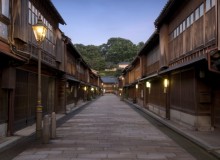
July 21, 2007
Spanish Sojourn
One train pass is all you need to experience three classic cities
By Metropolis
Originally published on metropolis.co.jp on July 2007

Photos by Simon Rowe
The Moors did it on horseback, the Civil War Republicans did it on bicycles, and Christian pilgrims still prefer to do it on foot. But short trips around Spain these days are a whole lot less of a slog with a Spain Flexipass.
With three days of unlimited rail travel inside a 60-day period for ¥25,800, one can hit the lively capital, Madrid, for its fine art, food and after-dark frivolities, then jump aboard one of the modern express trains headed for the great southern Moorish cities of Granada and Toledo.
MADRID
Life moves to a laid-back rhythm in this city of 5.5 million people—which is not to say Madrileños are without their passions. Just start with the Spanish proverb “Barriga llena, corazón contento,” which means, “Full stomach, happy heart.” It explains why two-hour lunches and feasting into the wee hours of weekday mornings are the norm. Dining in popular gourmet zones like the Puerta del Sol and Plaza Santa Ana, where the tapas bars and tabernas (pub-restaurants) fill the cobblestone streets with their sumptuous aromas, is a great way to live like a local.

Soul food awaits inside the vast Museo del Prado, one of Europe’s top art museums, where half a day passes quickly among the works of Picasso, Miro and Dali. The museum’s collection also features lavish canvases of old masters such as Rubens, Rembrandt and El Greco.
Around the Puerta de Sol, you’ll find boutiques brimming with reasonably priced leather goods, especially shoes, but for real bargain knickknacks and colorful photo opportunities, head for the sprawling Rastro flea market on Sunday, located south of the centrally located Plaza Mayor.
Plaza Mayor itself is a sight to behold. If you survive the shopping forays, then reward yourself with a creamy café con leche at one of the open-air cafés and scope out Madrid’s young fashionistas.
GRANADA
Water, water everywhere. The sound of it follows you like a stray dog in Granada. The gurgling of aqueducts beneath the sidewalks and the fizz of plaza fountains are like a balm to the senses after the eight-hour train ride south from Madrid.
Take a stroll through the old hillside Arab district, which is known as the Albaicin but is jokingly referred to as the place of “women, wine and water.” Streets here are called Aljibe de Trillo (Trillo Water Tank Street), Calle del Agua (Water Street) and Plaza Aqua, while the houses either side of them bear names like Carmen, Marcella and Maria on their painted tiles.
Al-hamra means “the red” in Arabic, and when the sun sets across Granada’s most endearing landmark, the palace-fortress built by Sultan Ibn Ahmar in the 13th century, you’ll realize why. Don’t be fooled by its compactness, however: the Casa Real (Royal Palace), the palace gardens of the Generalife, and the Alcazaba battlements take several hours to appreciate fully, and few sightseers manage more than one in a day.
The towering Renaissance facade of the city cathedral, too, never fails to pop the eyeballs and unhinge the jawbones of first-time visitors who step off the city’s main street, Gran Via de Colon, to view it. If you’re feeling puckish, drop into the nearby Via Colon café, where the maitre d’ shoots out orders as his waiters whistle their way across the marble floors with hot pastries and coffee for the breakfast crowds.
TOLEDO

Toledo is a city that leaps right out of the pages of Don Quixote. It’s not hard to imagine Cervantes’ hapless hero—an aspiring knight on a skinny steed—tracing the Rio Tajo around the city on his way to capture windmills across the plains of nearby La Mancha.
Use your rail pass for a day trip—it takes only 90 minutes from Madrid—and enjoy the visual treat of arriving at the city’s Moorish station, complete with intricate woodwork ticket counters, wrought-iron chandeliers, and a vast hand-tiled floor.
Rampaging Moorish tribes, Civil War bombardments and the harsh Castilian weather have all left their indelible marks on the city, though its 20 or so churches and chapels remain in remarkably good condition. You can join the rosy-cheeked nuns, robed in traditional habits, as they crowd the cafés around the cathedral for their morning hot chocolate and churros, a popular deep-fried pastry.
Toledo’s narrow streets that ooze medieval mystery are an escape from the tourist tides. Weave through the labyrinths around Calle de Santo Tomé, on towards the Visigothic extravagance of the churches of San Juan de los Reyes and Santa Maria la Blanca, and you’ll discover an intriguing array of architectural design that spans well over eight centuries.
The heavy wood doors and ornate bolted locks of the city’s private residences seem better suited to castle battlements. Don’t be discouraged, and give one a push—behind them lie some of Spain’s most enchanting courtyards, and nobody really minds if you take a peek.
ANA flies daily to Madrid, operating code share flights with Air France (via Paris) and Lufthansa (via Frankfurt). See www.ana.co.jp/eng for schedules and fare information. The Hostal La Perla Asturiana (www.perlaasturiana.com) is located in the heart of the city off the atmospheric Plaza Santa Cruz, 5min to the Museo del Prado and Puerta del Sol, 15min to Atocha train station; double rooms with bath from €48. In Granada, the Carmen de Santa Ines (www.carmensantaines.com) is a centuries-old hillside inn with balcony views of the Alhambra. Rooms €95-€200 (¥13,900-¥29,200). Toledo’s Hostal San Tomé (www.hostalsantotome.com), a quaint, family-run hotel, is handy to the local tabernas. Rooms from €50 (¥7,300). Spain Rail Passes are available in first- and second-class designations for 3-10 days of travel within a two-month period. Passes must be purchased before arrival in Spain. Contact Jalpak at 03-5520-0606 or see their website (http://fit.jalpak.co.jp). More info available from the Spanish Tourism Authority (www.spain.info) or Rough Guides Spain online (http://travel.roughguides.com).
[geo_mashup_map]







